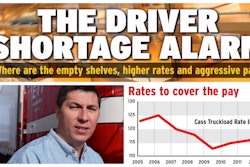We hear the reports all the time. “Driver shortage” at critical stage, Trucking needs young blood in the industry. ... DRIVE Safe Act this, pilot program for 18-year-olds that. I have written about it before, but all too often the reports we hear are generated by those paying for unused equipment – those who look out their office windows and see empty trucks sitting on the yard.
I understand this can be stressful. After all, that unused equipment often enough continues to generate bills, hitting the bottom line.
Yet state governments issue hundreds of thousands of CDLs every year. How can there possibly be a shortage?
All of those CDLs are undoubtedly not Class A, allowing for heavy transportation. All may not require DOT physicals, which may be the largest portion. That dovetails with where we most often here the term shortage applied -- in interstate transportation, or what we may refer to as long-haul or OTR. Put another way: pro drivers routinely spending a week or more away from home.
Yet I'm not alone in attributing empty equipment to driver churn, or turnover, rather than any true shortage of people interested in and/or qualified to do the work. Annualized driver turnover rates in trucking, according to various estimates, have fluctuated between around 80% and as much as 120% for more than three decades, with few exceptions – trucking companies with 100% percent annualized rates are effectively replacing the entire driver force every year.

[Related: The chicken-little tactics behind the 'driver shortage']
Churn, at the most basic level, is fairly simple to understand – an employed driver leaves one company for another, accepting better opportunities, better pay and benefits, more home time, maybe less stress. Rarely, though, do we hear the driver’s perspective of just why he or she left.
While some researchers do attempt to understand the correlations between retention and churn/turnover, the inability to accurately understand the professional long-haul truck driver and the reasons why they elect to leave a company I feel eliminates a major component of understanding cause and effect. Having almost 25 years of experience as a professional long-haul trucker myself, I feel as though I have a rare understanding of the issues truckers face daily. Putting on my psychology-doctoral-student hat, industry turnover numbers beckon investigation. Having studied psychology now for over 11 years, I have finally gotten to the level where I may be in a position to attack this question from the perspective of both the professional driver and researcher.
There can be many variables in a driver’s decision to leave a company -- or leave the industry altogether. Stress, health, relationships (professional and personal), finances, access to benefits, safety, regulations, drug testing, retirement … death. However, it will be my job as a researcher to narrow down and define these variables and look to possible correlations to retention and turnover. Simply understanding why is not enough. With turnover rates as they are, we must look to how these numbers can be changed benefiting not just the companies, but the professional driver as well.
What is best for the driver is all too often set aside as just another possible variable. This may be due to a prevalent attitude within the industry that drivers are a dime a dozen and easily replaced by another.
[Related: Is it overtime for company driver overtime pay?]
That brings me to my current need: participation in my research by both drivers and trucking companies. I’m working on my first residency requirement to complete my doctoral degree in industrial organizational psychology. In this process, I’m presenting my argument for the need of this research, what I am investigating (driver turnover in trucking), my approach to the investigation method and design (quantitative/qualitative), and ethical considerations.
Once approval is achieved, I can begin my investigation, hence my need for participants. I’m looking for company drivers and lease-purchase operators with trucking companies both large and small. I need at least one 1,000-plus-driver company’s participation, and at least two in the 100-1,000-driver range. Companies with fewer than 100, well -- the more participants available, the better chance there is of obtaining relevant results.
In order to avoid bias in the results, I can’t get into granular details. I can say, though, that participation will only require email correspondence, confidentiality forms, electronic surveys, and assessment. In other words, the time it will take driver participants is just 1-1.5 hours all told, easily achieved on a break.
As suggested, all driver and company information will remain anonymous. Companies may elect to be known through sponsorship if they choose. However, participation is what I am seeking, not funding. Interested parties may contact me via email at this link.
To begin the process I have a simple question for you: What are your reasons for leaving a trucking company? I have named a few already, but that's just one driver’s perspective. The driver's view is the foundation I must build upon. Email me with your perspective.













